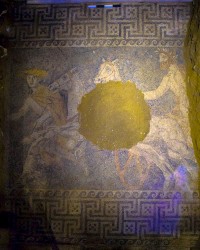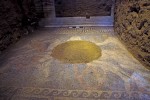 The excavation of the Kasta Tumulus in Amphipolis has already uncovered two headless sphinxes guarding the entrance, two pilasters underneath the sphinxes with the remains of black and red paint on the capital, a pebbled mosaic floor and in a second chamber beyond the portal, two caryatids. Now the Greek Culture Ministry has announced they also found a large, elaborate, colorful floor mosaic in the second chamber.
The excavation of the Kasta Tumulus in Amphipolis has already uncovered two headless sphinxes guarding the entrance, two pilasters underneath the sphinxes with the remains of black and red paint on the capital, a pebbled mosaic floor and in a second chamber beyond the portal, two caryatids. Now the Greek Culture Ministry has announced they also found a large, elaborate, colorful floor mosaic in the second chamber.
While the floor mosaic in the entrance chamber is made of irregularly shaped marble fragments set in red mortar, this piece is a pictorial mosaic of immense skill and artistic merit.
The mosaic, 10 feet long and 15 feet wide, depicts a horseman with a laurel wreath driving a chariot drawn by two horses and preceded by the god Hermes. According to a Culture Ministry announcement on Sunday, Hermes is depicted here as the conductor of souls to the afterlife.
The mosaic is made up of pebbles in many colors: white, black, gray, blue, red and yellow. A circular part, near the center of the mosaic, is missing, but authorities say enough fragments have been found to reconstruct a large part.
 Hermes, in his characteristic hat (petasos) and winged sandals, holds a caduceus as he leads the chariot and its noble driver from the east side of the chamber to the west. Around the central scene is a thick decorative frame almost two feet wide with geometric double meanders and squares framed with running spirals above and below.
Hermes, in his characteristic hat (petasos) and winged sandals, holds a caduceus as he leads the chariot and its noble driver from the east side of the chamber to the west. Around the central scene is a thick decorative frame almost two feet wide with geometric double meanders and squares framed with running spirals above and below.
The mosaic covers the entire floor of the second chamber excavated so far and archaeologists are hopeful that more of it will be revealed as they gradually dig away the soil filling the space to the east and west of it. Progress has been slow because the structure is delicate so the walls and ceilings have to be shored up with retaining walls and wood and steel beams as archaeologists cautiously remove the fill a little at a time.
The mosaic dates to the last quarter of the 4th century B.C., a range in keeping with the speculation that someone connected to Alexander the Great may have been buried in this tomb. As of yet, no names or inscriptions of any kind of found, nor any graves, for that matter.
 North of the mosaic is a marble threshold of the door that leads to the third chamber. Archaeologists are still working on removing the soil from the third chamber in small sections, but they have identified another door, which means there is probably a fourth chamber behind it. If there is any burial to be found in this tumulus, it’s likely to be in one of these two chambers. So far archaeologists have found three fragments of a marble door, a hinge and bronze and iron nails in a removed section of the soil in the third chamber. The door fragments are additional evidence that the site is indeed a Macedonian tomb (as opposed to, say, Roman, which at least one archaeologist has posited).
North of the mosaic is a marble threshold of the door that leads to the third chamber. Archaeologists are still working on removing the soil from the third chamber in small sections, but they have identified another door, which means there is probably a fourth chamber behind it. If there is any burial to be found in this tumulus, it’s likely to be in one of these two chambers. So far archaeologists have found three fragments of a marble door, a hinge and bronze and iron nails in a removed section of the soil in the third chamber. The door fragments are additional evidence that the site is indeed a Macedonian tomb (as opposed to, say, Roman, which at least one archaeologist has posited).
To get a better idea of the floor plan of what’s been uncovered so far, see this page. The whole site is an absolute gem, with clear explanations of past discoveries and regularly updated with new information and photographs from the tomb as excavation progresses.